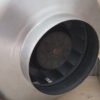The Basics of an Inline Exhaust Fan
A fan that is installed inline (within or attached to ducting) and utilized for extraction is known as an inline exhaust fan. An inline fan is often situated inside the attic or roof space, a little further away from the bathroom, rather than immediately on the plasterboard or ceiling.
Using an inline fan has a number of advantages.
- Reduced Noise – Because the fan is in the roof space rather than immediately above you, the noise levels in the room you’re extracting from will be lower. Additionally, if your roof space is sufficiently insulated or you choose a ‘silent model’ inline fan, it is one of the lightest ventilation options available.
- High Power – Inline fans with extremely high power motors are available in enormous sizes. This level of power is frequently unavailable from a regular ceiling or wall-mounted extractor fan.
- Length of duct run Ducting is designed to function with inline fans. In comparison to basic extraction fans, this implies they will keep a higher percentage of their indicated capacity. This is especially handy if the distance between the extraction site and the outflow is long. For example, if you want to extract your bathroom to a roof vent across a long distance (6m or more). As a result, the fans can be used for additional purposes, such as heat transfer and subfloor ventilation.
- More than one intake point – A Y Junction or BTO can be used with an inline fan to produce several inlets or outlets. This is especially beneficial if you have a large bathroom and want two input locations, or if you’re installing a heat transfer kit that serves numerous rooms.
Following components are needed to create an inline system
- Intake Vent – You’ll need an interior vent to serve as your system’s extraction point. To match your design, these grilles and vents come in a range of forms, sizes, and colors. It’s best to buy a vent that matches the diameter of the ducting you’ll be using.
- Ducting – To connect the vent to the motor and the motor to the exterior vent, you’ll need ductwork. We sell a variety of ducting, however the most typical type for bathroom extraction is conventional flexible ducting. We also have insulated and semi-rigid ducting in stock. It’s better if the ducting is kept as straight and direct as possible.
- Fan – The fan is the most important part of the system, and the fan you choose will be determined by factors such as the size of your room, the application, and so on.
- External Vent – This might be an external wall vent or a roof-mounted vent, and it completes the system. There are numerous options accessible.
Extras – To prevent backflow of air and to keep the system closed when the fan is not in use, a backdraft shutter can be added along the ductwork. Duct tape is usually sufficient to hold everything together, however worm clamps can also be used.
Major Type of Inline Fan
There are main three type of Inline fans are very popular
PolypropyleneInline Fan, MS Powder Coated Inline Fan, Galvanized Steel Inline Fan





